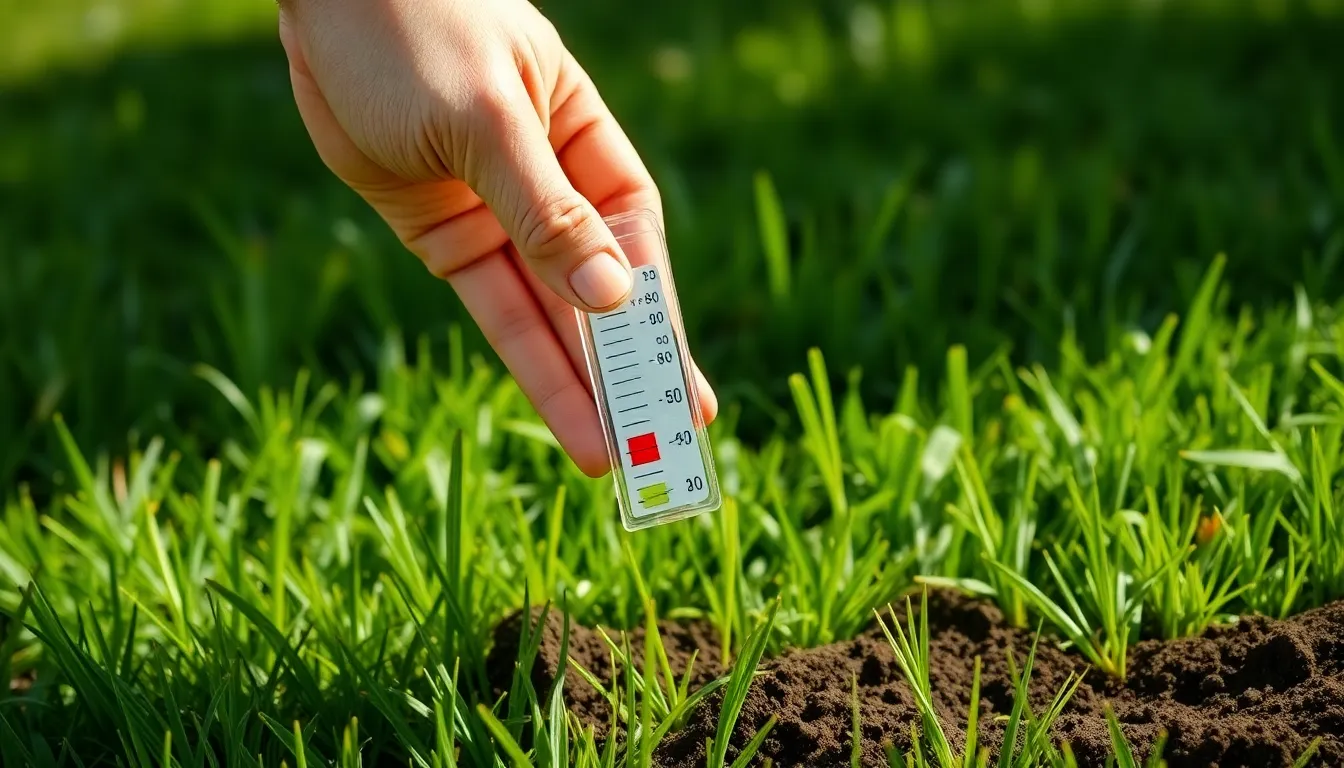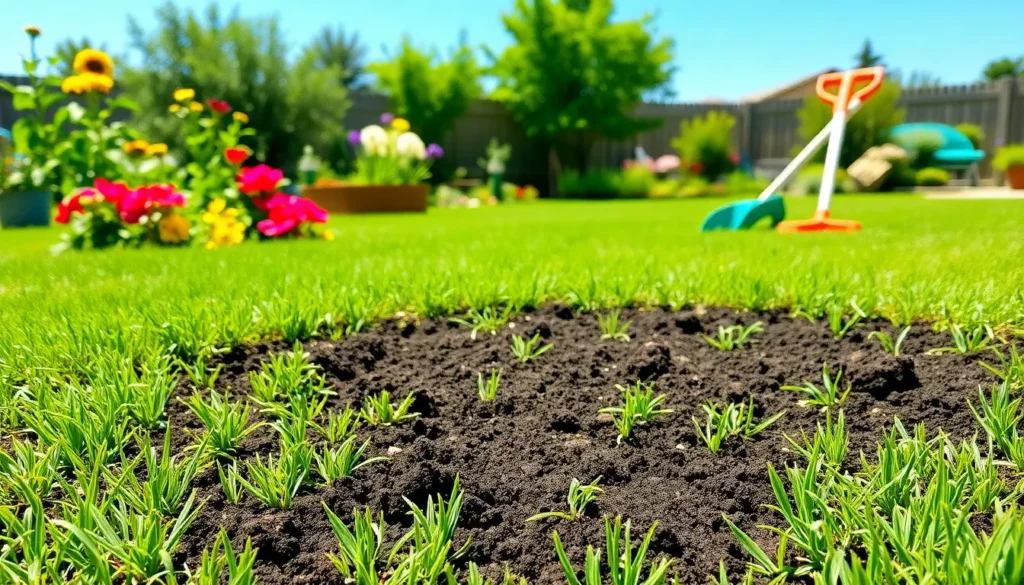Table of Contents
ToggleWhen it comes to achieving that lush green lawn everyone envies, the secret often lies beneath the surface. Choosing the best topsoil for grass isn’t just about filling holes; it’s about laying the foundation for a yard that could make even the most hardened gardener shed a tear of joy. Think of topsoil as the cozy blanket for your grass—warm, nutrient-rich, and oh-so-comfortable.
But wait! Not all topsoil is created equal. Some bags are packed with promises, while others are just glorified dirt. Navigating the topsoil jungle can feel like a game of roulette, but fear not! With a little guidance, anyone can find the perfect mix to transform their patch of earth into a verdant paradise. Let’s dig in and uncover the best topsoil options that’ll have grass growing like it’s auditioning for a lawn care commercial.
Understanding Top Soil
Topsoil functions as a crucial component for establishing a healthy lawn. It provides essential nutrients and promotes robust grass growth.
What Is Top Soil?
Topsoil refers to the uppermost layer of soil, typically ranging from 2 to 8 inches in depth. This layer contains a mix of organic matter, minerals, and microorganisms vital for plant health. Often dark in color, it enriches the soil structure, promoting water retention. Quality topsoil features a balanced texture, comprising sand, silt, and clay. This balance fosters optimal conditions for grass roots to thrive.
Importance of Quality Top Soil for Grass
Quality topsoil directly influences grass health and growth. Nutrient-rich topsoil supplies essential elements like nitrogen, phosphorus, and potassium, crucial for vibrant lawns. It enhances soil aeration, allowing roots to access air and moisture easily. A quality layer prevents compaction, ensuring that nutrients reach grass roots effectively. Furthermore, healthy topsoil supports beneficial microorganisms that boost soil fertility. Selecting quality topsoil lays the groundwork for a lush, resilient lawn.
Factors to Consider When Choosing Top Soil

Selecting quality topsoil involves considering several important factors that directly affect grass growth and health.
pH Level
pH level significantly impacts nutrient availability for grass. A range between 6.0 and 7.0 promotes optimal nutrient absorption. Soil testing kits can determine pH levels before selection. Acidic soil, with pH below 6.0, may lead to nutrient deficiencies, while alkaline soil above 7.0 can harm plant growth. Adjustments can enhance soil pH, improving conditions for thriving grass.
Texture and Composition
Soil texture and composition play crucial roles in overall health. A balanced mix of sand, silt, and clay creates ideal drainage and nutrient retention. Coarse-textured soil may drain too quickly, while fine-textured soil can retain excessive moisture. Topsoil should be rich in organic matter, enhancing microbial activity and nutrient cycling. Inspecting soil for consistency helps ensure that it supports robust grass growth.
Best Top Soil Options for Grass
Choosing the right topsoil option can significantly impact grass growth and lawn health. Here are three of the best choices available.
Option 1: Organic Top Soil
Organic topsoil enriches the lawn with essential nutrients. Typically derived from decomposed plant material, it offers a rich blend of organic matter and microorganisms. Grass benefits from the nutrient balance provided by organic options, leading to deeper root systems. This type of soil improves moisture retention and promotes healthier growth. Many homeowners prefer organic topsoil for environmentally friendly gardening practices. Checking for certifications ensures that the product meets quality standards.
Option 2: Peat-Based Top Soil
Peat-based topsoil consists primarily of decomposed peat moss. This option enhances soil acid levels, making it suitable for those targeting specific grass types. Water retention is notably improved, reducing the frequency of irrigation. Additionally, peat improves drainage, which supports root development. It’s essential to consider that while peat offers numerous benefits, sustainability issues arise because of peat extraction practices. Opting for sourced materials ensures that environmental impact remains minimal.
Option 3: Blended Top Soil
Blended topsoil combines various materials, such as compost, sand, and minerals. This mixture provides a balanced approach to soil texture and nutrient availability. Grass thrives in blended topsoil due to increased aeration and reduced compaction. While selecting blended options, quality varies among products, so sourcing from reputable suppliers is crucial. Facilities often create proprietary blends tailored for specific regional grass types, enhancing growth potential. Reviewing product ingredients helps in selecting the best blend for lawn care needs.
How to Apply Top Soil for Grass
Applying topsoil correctly ensures optimal growth for grass. The right techniques help create a strong foundation for a lush lawn.
Preparation of the Area
Clearing the area comes first. Remove debris, rocks, and existing grass to create a clean surface. Next, aerate the soil to improve water penetration and nutrient absorption. Soil testing provides valuable information about pH levels and nutrient needs. Address any nutrient deficiencies by adding amendments before applying topsoil. Leveling the area guarantees an even distribution of soil during application.
Correct Application Techniques
Spreading topsoil involves several straightforward steps. Use a shovel or a wheelbarrow for easier transport of topsoil to the area. When applying, aim for a layer thickness of 1 to 2 inches for effective coverage. Distributing evenly prevents any pockets of compacted soil that could hinder grass growth. Rake the topsoil to create a smooth surface that facilitates seed or sod placement. Water the area lightly after application to help settle the soil.
Choosing the right topsoil is crucial for cultivating a vibrant lawn. Quality topsoil not only provides essential nutrients but also enhances soil structure and promotes healthy grass growth. By considering factors like pH level and texture, individuals can make informed decisions that lead to a lush green yard.
Whether opting for organic, peat-based, or blended topsoil, sourcing from reputable suppliers ensures the best results. Proper application techniques further enhance the effectiveness of the chosen topsoil. With the right foundation in place, transforming any outdoor space into a thriving green oasis becomes an achievable goal.



